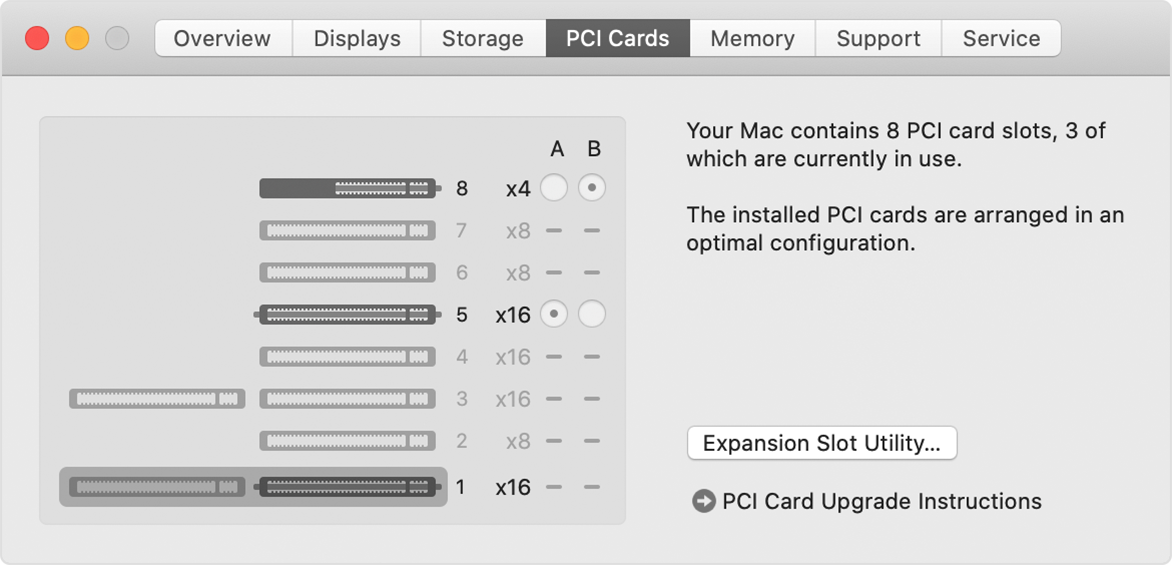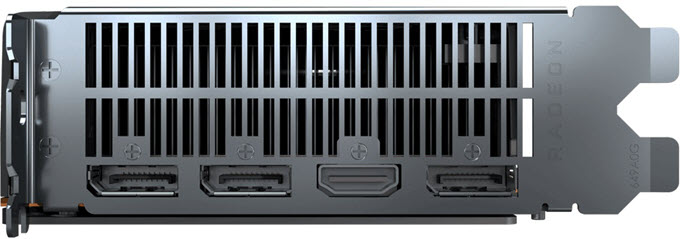Gpu Slot Types

An often overlooked yet vital factor when building a PC is power consumption. A top-of-the-line graphics card can significantly overbear the PSU and that is something gamers certainly do not want. To better understand GPU power connectors, we have prepared this resource for you.
Some low-end and lower-tier mid-range graphics cards can only use the PCI Express x16 slot to draw their power from, but more demanding ones will need to use 6-pin or 8-pin PCI Express power connectors. This can be particularly confusing when using a multi-GPU setup, like with the SLI. In that case, the power requirement is the sum of two (or more) connected graphics cards.
PCI Express x16 Connector
Motherboards come with the aforementioned PCI Express x16 slot that can provide a maximum of 75 watts of power. Some come with multiple PCI Express x16 slots in order to connect more GPUs, but like we’ve already said, this increases the required power.
6-Pin Connector
This connector can supply the GPU with an additional 75 watts of energy. What this means is that the graphics card will use PCI Express x16 slot and also draw power directly from the PSU (Power Supply Unit).
As well as another slot to add another GPU (blue), This can be seen on this pic below (my rig different mobo, but the same layout) We can see the PCI-E (red) slot that is still available see the picture below We also have slot for a gpu, however, if we added a another gpu it would again block the PCI slot below.
- Re: Video Card slot type Thanks for the info, at the time I ordered my system it was after a system crash while doing some beta testing and I thought that the best card availble was the 7300 LE.
- Width is measured in the number of PCI slots taken up by the graphics card on both your motherboard and chassis. The average width for most graphics cards is 2 slots, but some particularly beefy cards can come in at 3 slots. A few fall somewhere between that, though those are still (in effect) 3-slot cards since they still obscure the next slot.
Related:What Power Supply Do I Have?
Despite the fact that 150 watts is enough for most graphics cards, cards like Nvidia’s RTX 2080 require more than 220 watts and system power of 650 watts. Since 150 watts will be enough for most mid-range cards, these usually come with the 6-pin power connector.
The terms “PCI Express cables” or “PEG cables” (for PCI Express Graphics) can also be used to describe 6-pin connectors.
8-Pin Connector
Although the math doesn’t seem right when compared to the 6-pin connector, the 8-pin connector can deliver 150 watts to the graphics card. If the GPU requires more than 150 watts, it will, by design, come with an 8-pin connector or two 6-pin connectors.
As always, there are outliers. The most power-hungry graphics cards will come with a 6-pin and an 8-pin connector. For example, Nvidia’s GeForce GTX 1080 Ti has both types of connectors. As a result, it has a maximum power consumption of 250 watts.
There are even some outlandish situations where the GPU will have two 8-pin connectors. So, by simply adding all the numbers together, we get a total of 375 watts, but that is truly an extreme case. On top of that, you still need to power the CPU (which is another big energy spender) and the rest of the components.

It’s safe to say that your machine will be properly powered with a decent 650 watts PSU, although if you’re building a gaming rig and want to future proof it (which, let’s be honest, is nearly impossible), you can get a more powerful PSU. But be careful because with great power comes a greater risk ofoverheating.
There is also a rule of thumb that the PSU runs best when it’s at 50% capacity, but that is a different topic that should be looked at on a per-case basis.
12-Pin Connectors
With the release of Nvidia’s RTX 3000 series, we were introduced to 12-pin power connectors. This was a move out of necessity as Nvidia really needed the extra power for their all-powerful cards and they actually came up with a rather elegant solution.
A 12-pin connector is roughly the size of an 8-pin connector, although it can logically draw a lot more power. Nvidia was forthcoming in regard to the availability of PSUs with 12-pin connectors, so it released an adaptor which allows two 6-pin connectors to interface with its card’s 12-pin slot.
Adapters Or Converters For Connectors
There are often compatibility issues when building a PC and power connectors are no different. Luckily, computers are made by engineers who like to modify stuff that’s not fitted to their needs by default.
A company by the name of Molex pioneered these pin connectors all the way back in the late 50s and early 60s, and has since become synonymous with the term. So don’t be surprised to hear these referred to as Molex Adapters or Molex Converters.
4-Pin Molex to 6-Pin PCI-E Adapter Cable
You’ll want to use this cable if your graphics card requires a 6-pin power connector but your PSU doesn’t have it. That’ll actually be a sign of a very old PSU, so maybe it’s time for an upgrade. If you’ll still stick to your guns, know that this sort of adapter can sometimes require one 4-pin connector, but it’ll most often be two, which is the recommended option.
4-Pin Molex to 8-Pin PCI-E Power Adapter Cable
This cable uses two 4-pin connectors and adapts it to an 8-pin connector. 4-pin to 8-pin is something that will likely be most useful with upper mid-range and high-end graphics cards.
6-Pin to 8-Pin PCI-E Adapter Cable
If you’ve recently purchased a top-class GPU, it will likely require an 8-pin connector, which some PSUs might not have. In that case, the 6-pin to 8-pin adapter is the solution for you.
2x 8-Pin To 12-Pin PCI-E Adapter Cable
As mentioned earlier, the 12-pin power connector is the latest technology necessary for Nvidia’s 3000 series graphics cards. Because there was a relatively small supply of PSUs with a 12-pin power connector upon the launch of the 3000 series, Nvidia included a dual 8-pin to 12-pin adapter with its packing.
SATA to 6-Pin PCI-E Adapter Cable
This cable converts your SATA connectors to a 6-pin one, but this is generally advised against. It’s possible that SATA won’t be able to handle the power that your graphics card may require and this situation is not something that you want to be in the middle of, especially if the cable is labeled as “SATA only“.
Gpu Slot Types
SATA to 8-Pin PCI-E Adapter Cable
Likewise, SATA can also be adapted to an 8-pin power connector. In this particular scenario, there will be two SATA connectors for one 8-pin connector.
Cpu Slot Types
Important Note About Adapters
In most cases, it’s best to upgrade your PSU if you lack connectors, as it might be the case that they weren’t built with your power consumption in mind. If possible, it’s best to use Molex to Molex for your GPU needs, as they have thicker wires and can offer more current. A SATA to Molex adapter might be exposed and lead to burnout if the GPU draws more power with a higher load or by overclocking.
You Might Like These Too
A video card slot is the spot inside a computer that is specifically designed to hold a video card. There are three common types of video card slots available: peripheral component interconnect (PCI); accelerated graphics port (AGP); and peripheral component interconnect express (PCI-E). In order for a video card to fit inside the computer, the video card slot and video card need to be of the same type. This slot connects directly to the northbridge section of the computer’s chipset, allowing fast communication between the graphics card and the rest of the computer.
Graphics Slot Types

Gpu Slot Types
Inside a computer, there are several expansion slots on a motherboard. These slots allow new hardware to interface with preexisting hardware, increasing the capabilities of the computer. Most motherboards have a single slot in the highest position on the board that is specifically for a video card. Unlike the other slots, where you can plug a card into any compatible slot, this one is for video cards only.
There have been several different video card slot types over the years. On a modern computer there are only three common types, from least to most common they are PCI, AGP and PCI-E slots. Older computers have other kinds, such as industry standard architecture (ISA) or video electronics standards association (VESA), but these types are nearly unheard of today.

The PCI interface was the standard video card slot type until the mid-90s. While it is nearly gone today, this slot type may still be found on some older office computers and on very low budget parts. Even though it is rarely used for video cards, this slot design is still the standard for many types of expansion cards, such as sound or network cards. As a result, PCI slots are still on most modern motherboards, they are just not used for video cards.
AGP video card slots took over from PCI as the most common style. They were on nearly every computer from the mid-90s until the mid-00s. AGP cards slots commonly have multipliers associated with them, such as x2, x4 or x8, that indicate the speed of the port. In order to utilize the slot to its fullest, it needs an AGP card with the same multiplier.
The most common style of video card slot today is PCI-E. This slot type took over from AGP in the mid-00s as the default type. While APG cards are far from gone, PCI-E has taken over the market in the late-00s. These slots are very fast, which allows for more powerful video cards.